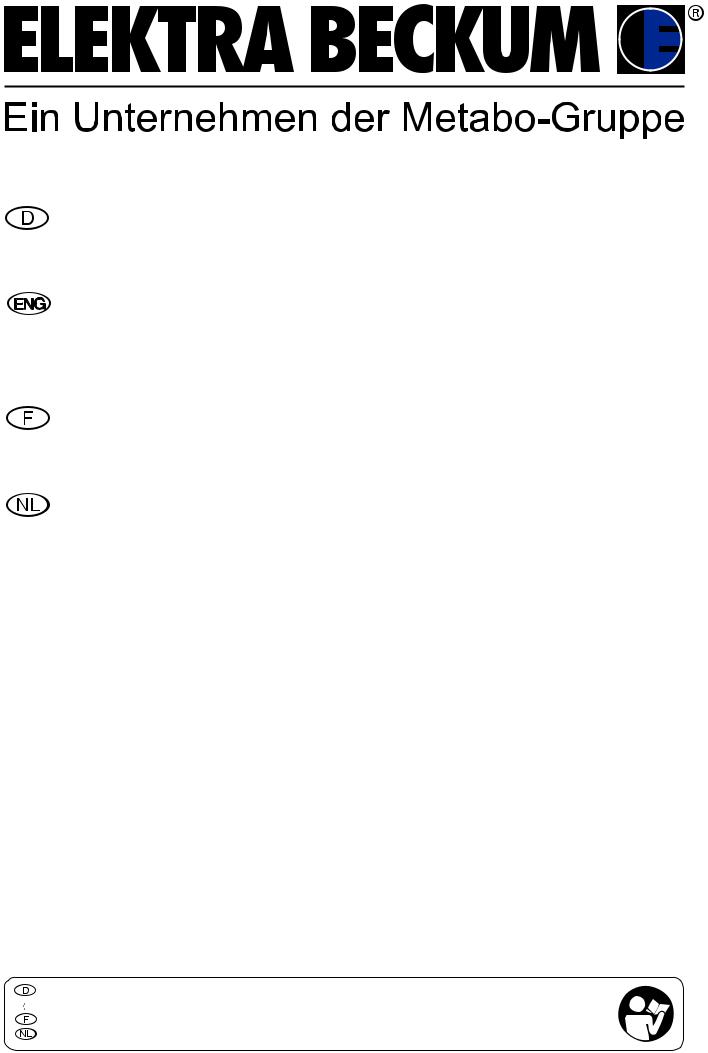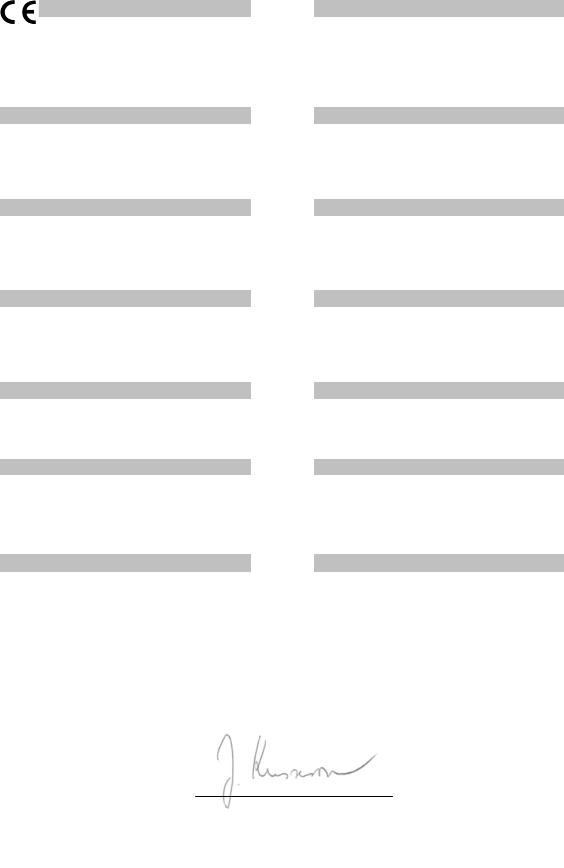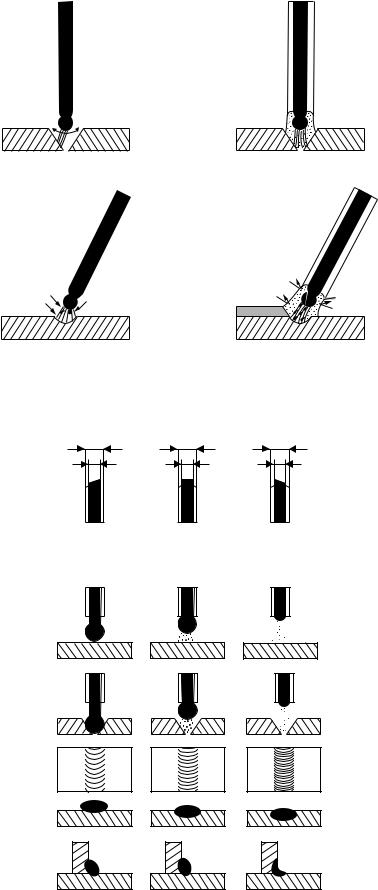Metabo SB 200 CT, SB 160 C User Manual

Betriebsanleitung
Schweißgeräte mit stufenloser Regelung
Operating Instructions
Welding Transformers and Rectifiers with Stepless Current Control
Instructions d'utilisation
Appareil de soudure avec réglage en continu
Handleiding
Lasapparaten met traploze instelling
SB 160 C / SB 200 CT
115 117 9491 / 2402 - 3.2 / de, en, fr, nl
Achtung! Lesen Sie diese Anleitung vor der Installation und Inbetriebnahme aufmerksam durch.
 Attention! Carefully read through these instructions prior to installation and commissioning.
Attention! Carefully read through these instructions prior to installation and commissioning.
Attention ! Prière de lire attentivement la présente notice avant l'installation et la mise en service. Oppassen! Lees deze instructies voor de installatie en ingebruikname aandachtig door.

D DEUTSCH
KONFORMITÄTSERKLÄRUNG
Wir erklären in alleiniger Verantwortlichkeit, daß dieses Produkt mit den folgenden Normen übereinstimmt* gemäß den Bestimmungen der Richtlinien**.
F FRANÇAIS
DECLARATION DE CONFORMITE
Nous déclarons, sous notre seule responsabilité, que ce produit est en conformité avec les normes ou documents normatifs suivants* en vertu des dispositions des directives **
IT ITALIANO
DICHIARAZIONE DI CONFORMITÀ
Noi dichiariamo sotto la nostra esclusiva responsabilità che il presente prodotto è conforme alle seguenti norme*. in conformità con le disposizioni delle normative **
PT PORTUGUÊS
DECLARAÇÃO DE CONFORMIDADE
Declaramos sob nossa responsabilidade que este produto está de acordo com as seguintes normas*.de acordo com as directrizes dos regulamentos **
FIN SUOMI
VAATIMUKSENMUKAISUUSVAKUUTUS
Vakuutamme, että tämä tuote vastaa seuraavia normeja*.on direktiivien määräysten mukainen**
DA DANSK
OVERENSSTEMMELSESATTEST
Hermed erklærer vi på eget ansvar, at dette produkt stemmer overens ed følgende standarder*. iht. bestemmelserne i direktiverne**
EL ΕΛΛHNIKA
∆ΗΛΩΣΗ ΑΝΤΙΣΤΟΙΧΕΙΑΣ ∆ηλώνουµε µε ιδία ευθύνη ότι το προϊόν αυτό αντιστοιχεί στις ακόλουθες προδιαγραφές* σύµφωνα µε τις διατάξεις των οδηγιών**
ENG ENGLISH
DECLARATION OF CONFORMITY
We herewith declare in our sole responsibility that this product complies with the following standards*
in accordance with the regulations of the undermentioned Directives**
NL NEDERLANDS
CONFORMITEITSVERKLARING
Wij verklaren als enige verantwoordelijke, dat dit product in overeenstemming is met de volgende normen*
conform de bepalingen van de richtlijnen**
ES ESPAÑOL
DECLARACION DE CONFORMIDAD
Declaramos bajo nuestra exclusiva responsabilidad, que el presente producto cumple con las siguientes normas*.de acuerdo a lo dispuesto en las directrices**
SV SVENSKA
FÖRSÄKRAN OM ÖVERENSSTÄMMELSE
Vi försäkrar på eget ansvar att denna produkt överensstämmer med följande standarder*. Enligt bestämmelserna i direktiven**
NO NORGE
SAMSVARSERKLÆRING
Vi erklærer under eget ansvar at dette produkt samsvarer med følgende normer*. henhold til bestemmelsene i direktiv**
POL POLSKI
OŚWIADCZENIE O ZGODNOŚCI
Oświadczamy z pełną odpowiedzialnością, że niniejszy produkt odpowiada wymogom następujących norm*.według ustaleń wytycznych **
HU MAGYAR
MEGEGYEZŐSÉGI NYILATKOZAT
Kizárólagos felelősségünk tudatában ezennel igazoljuk, hogy ez a termék kielégíti az alábbi szabványokban lefektetett követelményeket*.megfelel az alábbi irányelvek előírásainak**
SB 160 C - SB 200 CT
*EN 50060; EN 55014 (1993); DIN EN 61000-4-1 (1993), EN 60974-1
**89/336/EWG, 73/23/EWG
Dipl. Ing. Jürgen Kusserow
Vorstand
ELEKTRA BECKUM AG – Daimlerstraße 1 – 49716 Meppen
Tel.: +49 59 33 80 20
1000965/ 00

ENG
Contents
1Specifications
2Taking a Single-Phase Machine Into Operation
2.1Taking a Combination 1-Ph/2-Ph Machine into Operation
3General Information for Welding Transformer/Rectifier Operators
3.1Overview of Stick Electrodes and their correct Use
3.1.1Care of Stick Electrodes
3.1.2Function of the Stick Electrode Coating
3.1.3Classification of Stick Electrodes according to DIN 1913
3.1.4Selecting Suitable Electrodes for a Welding Task
3.1.5Arc Starting and Arc Burning
3.1.6Welding Positions According to DIN 1921
4Welding Hints
4.1Weld Types
4.2Weld Flaws and possible Causes - Shown on Fillet Welds 5 Accessories and Accessory Maintenance
6 Wiring Diagrams
You have bought a high-quality electric arc welding machine, designed and built by specialists with many years of experience. A machine built to last, giving a long service life.
All models have the correct size power supply cable fitted, the transformer‘s core is made from top-quality insulated sheet steel, to keep eddy currents and cyclic magnetization losses to an absolute minimum.
Please read the instructions given in the manual in order to fully utilize the potential of your machine.
Know and adhere to all local safety codes and regulations governing the operation of electric arc welding machines.
User Responsibility
The operation of the welding divice in the data processing system environment is not allowed!
This product shall only be used as specified. Any other use requires the written consent of Elektra Beckum AG, P.O.Box 1352, D-49703 Meppen, Germany
Please contact your dealer for any warranty claims.
Warranty work will essentially be carried out by service centres authorised by us. Repairs beyond the warranty period may be carried out only by our authorised service centres.
Please preserve all repair invoices! We reserve the right to make technical changes!
We recommend attending a welding course at a recognised technical institute.
1 |
Specifications |
|
|
|
|
|
|
Model |
SB 160 C |
SB 200 CT |
SB 200 CT |
||
|
Main voltage |
230/400 V |
240 V |
230/400 V |
||
|
Mains frequency |
50/60 Hz |
50 Hz |
50/60 Hz |
||
|
Welding steps |
stepless |
stepless |
stepless |
||
|
Stepless at 230 V |
32 |
- 38 V |
47 - 55 V |
31 |
- 39 V |
|
Stepless at 400 V |
38 |
- 46 V |
|
41 |
- 50 V |
|
Max. OCV at 230 V |
16 A time-lag |
32 A time-lag |
16 A time-lag |
||
|
Max. OCV at 400 V |
16 A time-lag |
|
20 A time-lag |
||
|
Insulation class |
|
H |
H |
|
H |
|
Protection class |
IP 21 |
IP 21 |
IP 21 |
||
|
Setting range, stepless 230 V |
30 - 110 A |
70 - 180 A |
20 - 110 A |
||
|
Setting range, stepless 400 V |
65 - 155 A |
|
60 - 180 A |
||
|
Cooling |
|
self |
fan |
|
fan |
|
Weldable electrodes at 230 V |
Ø 1.6 |
- 2.5 mm |
Ø 2,0 - 4,0 mm |
Ø 1.6 |
- 2.5 mm |
|
Weldable electrodes at 400 V |
Ø 2.0 |
- 3.25 mm |
|
Ø 2.0 |
- 4.0 mm |
2 Taking a Single-Phase Machine into Operation
This machine is to be connected to the power mains via a Earth Fault Circuit Interrupter of 30 mA capacity. Worn or damaged power cables should be replaced immediately by a qualified electrician.
Do not operate this machine with a damaged power cable, danger of personal injury by electric shock. Children are not permitted to operate this machine.
Connect to an earthed single-phase 230/240 V outlet, protected by a 16 A time-lag fuse. Operating other electric machines or appliances on the same circuit while welding is only possible to a very limited extent and not recommended.
Earth and welding cable are firmly attached to the machine. Polarity does not matter with AC welding current.
13
Attach earth clamp to the workpiece, close to the weld seam and on bare metal for good conduction. Place stick electrode into the electrode holder.
With the handwheel select the desired welding current.
If there is not power outlet near the work area an extension cable is required. The cable's lead cross section must be at least 2.5 mm2. Uncoil extension cable fully to prevent heatbuild-up by inductance. Inductance also conside-rably reduces the welding current. Extension of the welding cables is also possible, but the cross section of the extension cables must be larger than that of the cables supplied with the machine.
Every machine is protected against overloads by a thermo switch, which switches the power to the transformer off if it becomes too hot. After a short cooling-down period the machine will switch back on automatically. Model SB 200 CT is equipped with a fan for forced cooling, given better performance with a higher duty-cycle.
3 General Information for Welding Transformer/Rectifier Operators
Dust, dirt and metal chips will harm any welding machine. It is of particular importance that the air ventilation for cooling is not obstructed.
A weld should join two work pieces as if they were made from a single piece. Prior to the welding the joints must be cleaned and dirt, rust, grease and paint removed. Also slag from previous welds must be completely removed. Attach earth clamp firmly to work piece, assuring good metal to metal contact. Check that all cables and connectors are in proper operating condition to ensure proper current conduction.
Place electrode with the uncoated end into one of the electrode holder's notches. Each welding machine is supplied complete with an accessory kit, comprising the welding cables, a welding visor and a slag hammer. When removing slag it is recommended to protect the eyes by suitable means (goggles) from injury by sharp and hot slag. The welding visor's dark glass plate protects the eye against ultra-violet and infrared rays. The clear glass plate protects the dark plate against spatters and damage. The dark protective glass is available in different shades for different types of electrodes and to suit different eye sensivity. Normally for electrodes from 1.5 mm to 4 mm Ø protective glasses of shade DIN 9 are used, for electrode over 4 mm Ø shade DIN 10.
Select the correct welding current as shown below:
Current (A) |
Electrode Ø |
Material Thickness |
||
25 |
- 50 |
1.0 - 2.0 mm |
1.0 |
- 2.0 mm |
50 - 100 |
2.0 - 2.5 mm |
2.0 |
- 4.0 mm |
|
100 |
- 140 |
2.5 - 3.25 mm |
4.0 |
- 8.0 mm |
140 |
- 220 |
3.25 - 5.0 mm |
8.0 - 12.0 mm |
|
220 |
- 300 |
5.0 - 6.0 mm |
12.0 |
- 20.0 mm |
In principle do not use too thick an electrode. As a general rule calculate 40 amps welding current per 1 mm of electrode diameter. Depending on electrode type, material thickness and weld position this calculated value may have to be adjusted to plus or minus. All machines work well with thin plate from 1.0 mm thickness.
3.1 Care of Stick Electrodes and their correct Use
In order to achieve a good weld the electrode has to be dry, thus storing in a dry place is essentialShould electrodes have become moist, dry in an oven at between 200° C to 300° C for 30 minutes.
Basic coated low-hydrogen type electrodes always require pre-drying at 200° C to 300° C for 3 hours as atomic hydrogen causes weld flaws.
The designation of welding electrodes is standardized by DIN 1913. The designation is stipulated by the electrode manufacturers in accordance with the standard and checked by an inspection body. It is printed on the electrode packet.
3.1.1 Coding of Stick Electrodes according to DIN 1913
Example: |
|
|
|
|
|
|
|
|
|
|
|
|||||||
Stick electrode |
DIN 913 - |
E |
43 3 |
2 |
AR 7 |
|||||||||||||
|
|
|
|
|
|
|
|
|
|
|
|
|
||||||
Type of electrode Number of DIN standard |
|
|
|
|
|
|
|
|
|
|
|
|||||||
|
|
|
|
|
|
|
|
|
|
|
||||||||
Code for manual electric arc welding |
|
|
|
|
|
|
|
|
|
|
|
|
||||||
|
|
|
|
|
|
|
|
|
|
|
|
|||||||
Code number for tensile strength, |
|
|
|
|
|
|
|
|
|
|
|
|||||||
yield point and elongation |
|
|
|
|
|
|
|
|
|
|
|
|
|
|||||
|
|
|
|
|
|
|
|
|
|
|
|
|
||||||
Code number for impact |
|
|
|
|
|
|
|
|
|
|
|
|
||||||
engergy of 28 Joule minimum |
|
|
|
|
|
|
|
|
|
|
|
|||||||
Code number for increased impact |
|
|
|
|
|
|
|
|
|
|
|
|||||||
energy of 47 Joule minimum |
|
|
|
|
|
|
|
|
|
|
|
|
||||||
Code for coating |
|
|
|
|
|
|
|
|
|
|
|
|
||||||
|
|
|
|
|
|
|
|
|
|
|
|
|||||||
Code number for electrode class |
|
|
|
|
|
|
|
|
|
|
|
|
||||||
|
|
|
|
|
|
|
|
|
|
|
|
|||||||
14

3.1.2 Function of the Stick Electrode Coating
Stabilization of the arc and lonization of the arc space
Protection of the weld metal from atmospheric oxygen and nitrogen
bare |
coated |
electrode |
electrode |
unstable |
stable |
arc |
arc |
bare |
coated |
electrode |
electrode |
slag |
shielding gas |
|
This protection is achieved by the generation of shielding gases and slag during the melting of the electrode.
Compensation of alloy burn-off.
Stick Electrodes According to DIN 1913
Coating thickness |
D |
|
d |
||
|
||
|
light |
|
|
D = 1.2 · d |
D |
d |
medium |
D > 1.2 · d |
< |
but = 1.55 · d |
D |
d |
heavy
D > 1.55 · d
Material transfer
Gap bridging ability
Weld seam appearance
Penetration depth
Types of Coating
Aacid coated
R |
rutile light and medium coating |
RR |
rutile heavy coating |
AR |
rutile acid coating |
Ccellulose coating
R(C) |
rutile cellulose medium coating |
RR(C) |
rutile cellulose heavy coating |
Bbasic coating
B(R) |
basic coating with non-basic proportions |
RR(B) |
rutile basic heavy coating |
15
